☎: +84 976 489 888 (VN) / ☎: +84 937 191 888 (EN) ✉: info@vietsensetravel.com
DAILY TRADITIONAL VIETNAMESE FOOD
Nem ran (Spring roll)
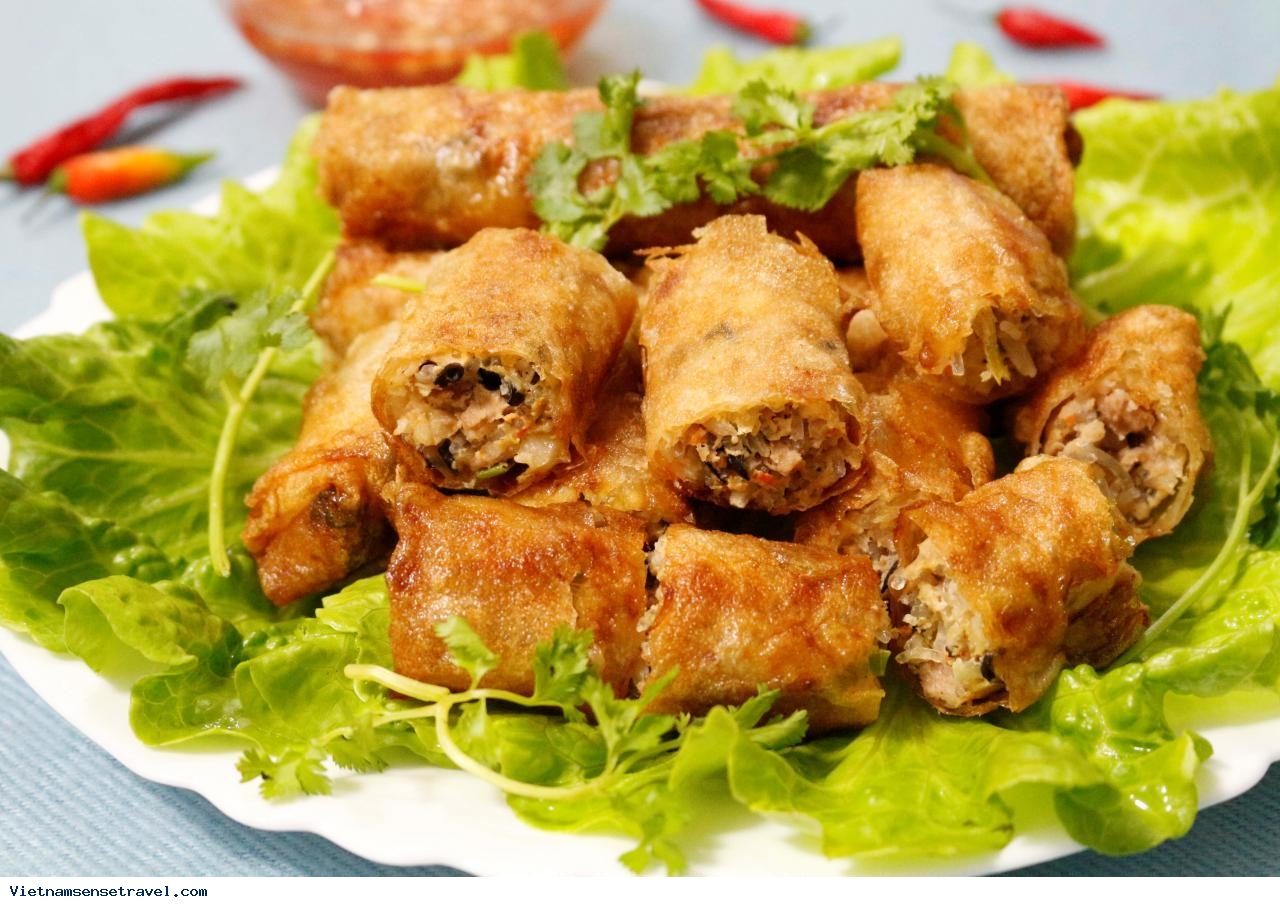
Nem ran (called cha gio in the south) is a much-appreciated speciality, although it is very easy to prepare. Since long ago, nem ran has been a familiar dish on the menu at all households during the New Year’s festivities, at family parties, and at receptions.
The stuffing of the nem ran is comprised of mince pork, sea crabs, eggs, minced Jew's ears, thin-top mushroom, dried onions, bean-sprouts, pepper, spiced salt, etc. The mixture is then rolled in flat rice cakes and fried in a pan until crispy.
Nem are eaten hot with a sauce that it is, at the same time, somewhat salty, sweet, acidic and scented (with the flavours of onion and pepper). Papaya and a few fresh scented vegetables are added.
Gio lua (Silky lean meat paste)
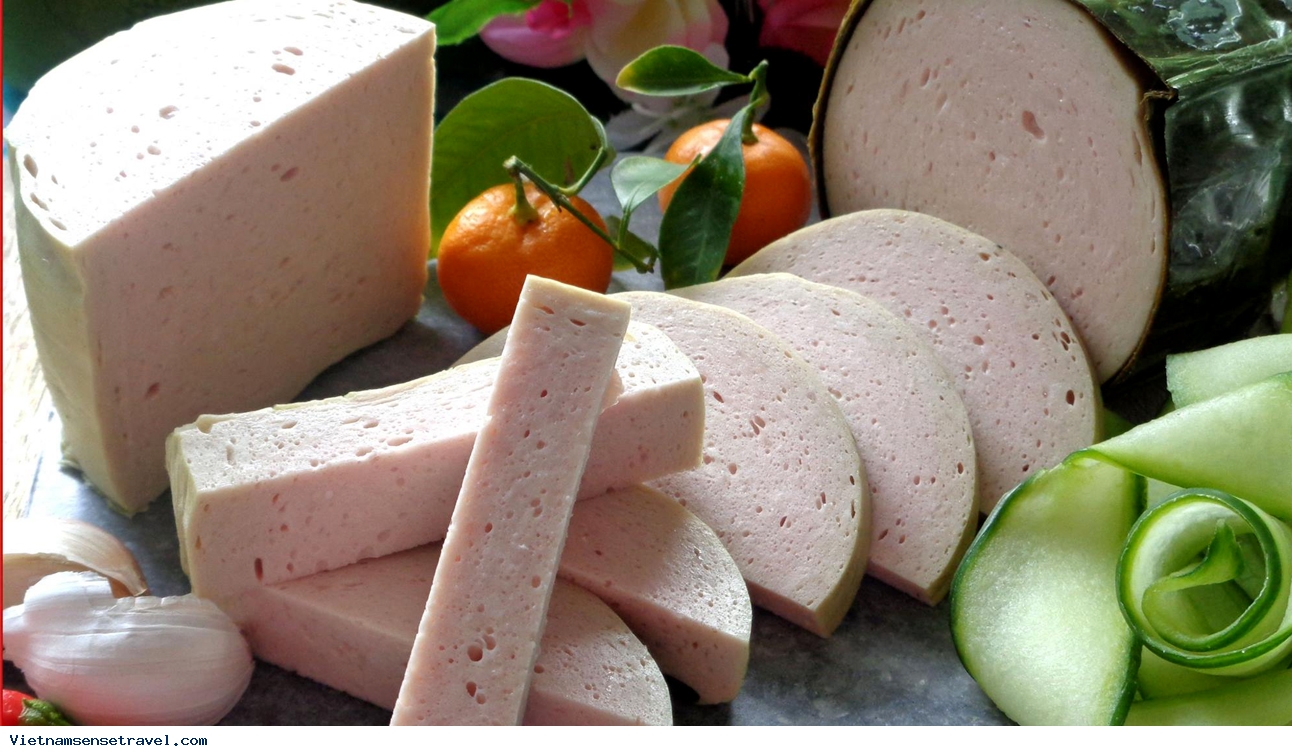
By itself, the name “silky lean meat paste” evokes thoughts of the silky aspect of this speciality. Gio lua is made with lean pig meat, which is pounded with a pestle until it becomes a sticky paste. Fresh banana leaves are tied very tightly around the paste, and then it is well cooked. Good gio lua has a fine white colour, is firm, and has a perfumed and sweetish taste.
Gio lua may be obtained anywhere in Viet Nam, but the best gio lua is from Uoc Le Village (Ha Noi), where the know-how for Gio lua is strictly kept so as to allow no secrets of the job to flow out from Uoc Le. Slices of Gio lua are slightly pink, moist, and sweet-smelling meat, fish sauce and banana leaf.
TET TRADITIONAL FOOD:
Banh Chung and banh Tet (Boiled rice and pork cakes)
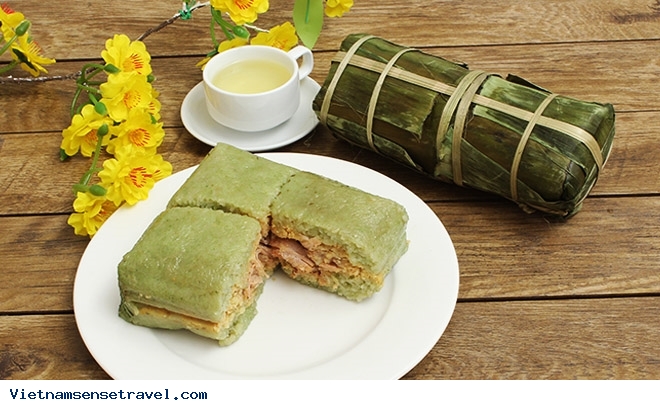
Boiled rice and pork cakes are usually cooked 2-3 days before Tet. Both can be kept for about two weeks in cool temperature. However, after this time they become hard and must be re-boiled.
Soak some green beans overnight in water to soften. Drain, rub and clean to remove the skin, and leave to dry. Next, cook the beans in a steamer and grind. Form into balls the size of tennis balls.
Soak some glutinous rice overnight. Clean and rinse. Mix with a little salt. Cut fresh pork meat (lean or fat, according to personal taste) into 2cm strips. Mix with salt, fish sauce and pepper, and leave for about one hour.
Clean dong leaves (leaves from arrowroot) and place them over each other to form a cross. Place an amount of rice in the centre of the leaves. Shape into a square (the southern version is in a circle). Press a "ball" of green bean on top. Then, add 1-2 pieces of marinated pork, then more green bean, and finally rice. Press firmly into a compact square and wrap the leaves over to cover the cake completely. Tie with bamboo strings. Place in a large pot of boiling water and boil overnight. Squeeze the moisture out by placing it in a colander with a heavy object on top.
To serve, untie and open the leaves. Invert on a plate and cut into pieces using the bamboo strings, not a knife. Serve cold.
Canh mang (Dried bamboo shoot soup)
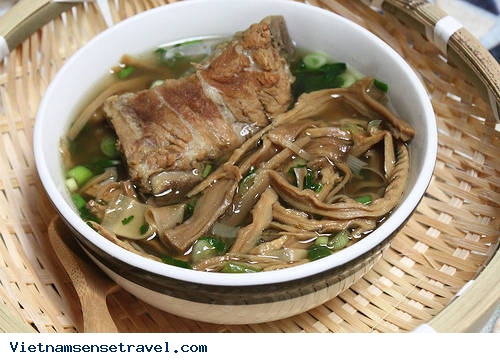
Soak dried bamboo shoots in water for 2-3 days to soften. Boil 2-3 times if necessary. Cut into 5cm strips. Fry with pig trotters and salt. Add water, bring to boil and simmer until meat is tender. Garnish with green onion.
Bong (Dried pig skin)
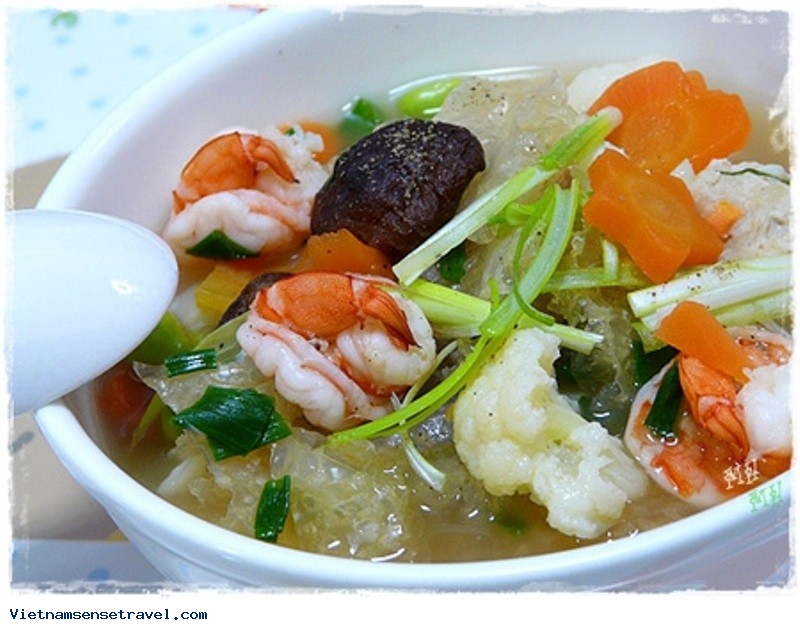
Soak dried pig skin (the skin should be yellow, which means it has been pre-treated) in water for one hour. Drain and then add a cup of rice whisky and fresh ginger. Rub onto the skin (this will remove the smell). Cut into diamond-shaped pieces.
To make fresh chicken stock, add dried shrimps and dried huong (perfume) mushrooms, which have been pre-soaked in warm water, to 2-3 chicken carcasses. Bring to boil and simmer. Remove the dried mushrooms. Cut carrot and kohlrabi into decorative shapes (flowers, leaves etc). Boil the dried pork skin in the chicken stock for several minutes until tender. Add French/ string beans. To serve, mix all drained ingredients (place vegetables on top) and garnish with coriander.
Hanh muoi (Pickled onions)
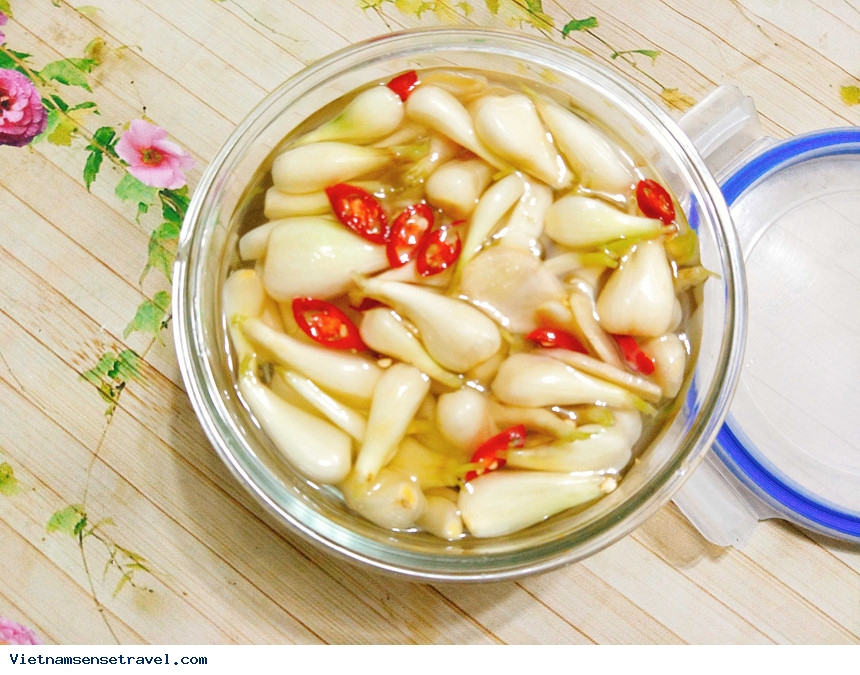
You should make this dish about two weeks before Tet. Clean onions. Dissolve some salt and sugar in warm water. Add onions, cover and keep in a clean, dry place for two weeks.
Mien (Vermicelli noodles)
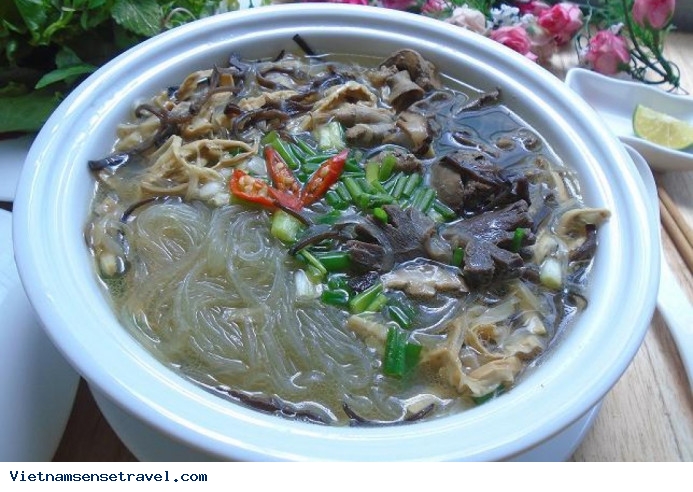
Cut mien into lengths and pre-soak for 10-15 minutes in water. Boil chicken innards (liver, heart, etc), salt and green onions in a fresh chicken stock. Mix with mien and serve.
Moc (Pork soup)
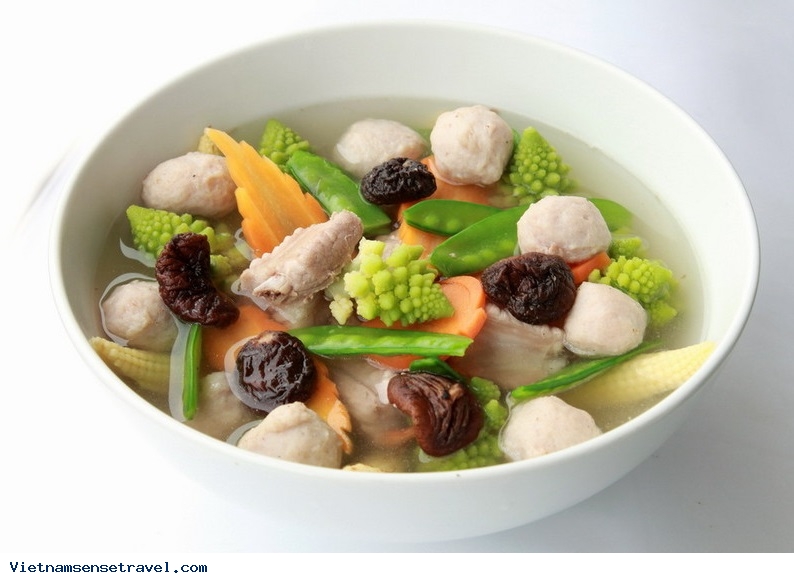
Buy raw minced pork. Add dried mushrooms, which have been soaked to be softened. Mound pork on the mushrooms and boil in chicken stock.
Ga ran or luoc (Fried or boiled chicken)
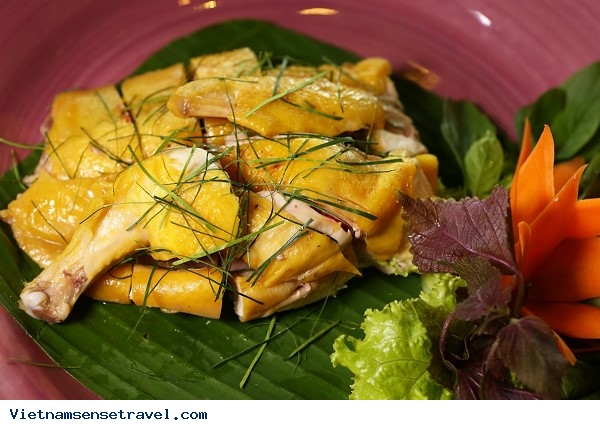
Fried version: marinate raw chicken in salt, sugar, garlic, fish sauce and burnt sugar. Fry chicken and marinade in oil.
Boiled version: served with julienne lemon grass.
Ca chep kho rieng (Carp with galangal)
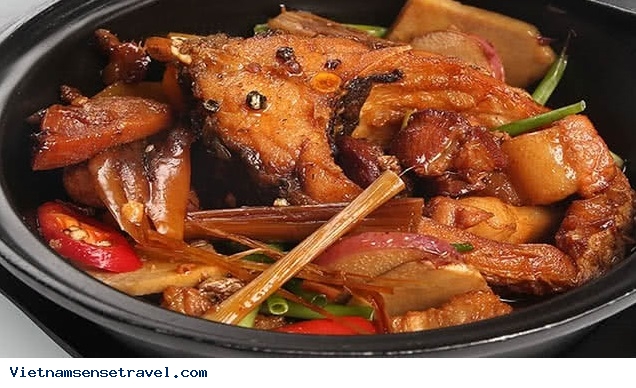
Scale carp, cut into steaks and fry. Add finely sliced galangal, fish sauce, salt, burnt sugar and water (this makes the fish turn dark brown). Cook over a low heat until the fish is hard and little liquid remains.
Bo kho que (Beef with cinnamon)
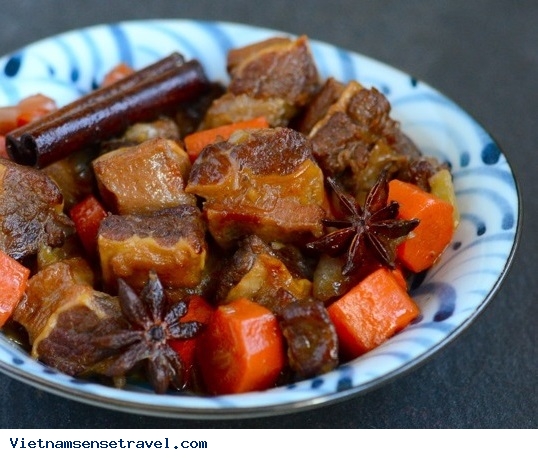
Tie up beef muscle firmly with several strips of bamboo. Break cinnamon into small pieces, rub into beef. Sear.
Add fish sauce and salt, and cook over a low heat. Only cut beef when about to serve. The meat should be firm but not tough.
Xoi gac (Steamed momordica glutinous rice)
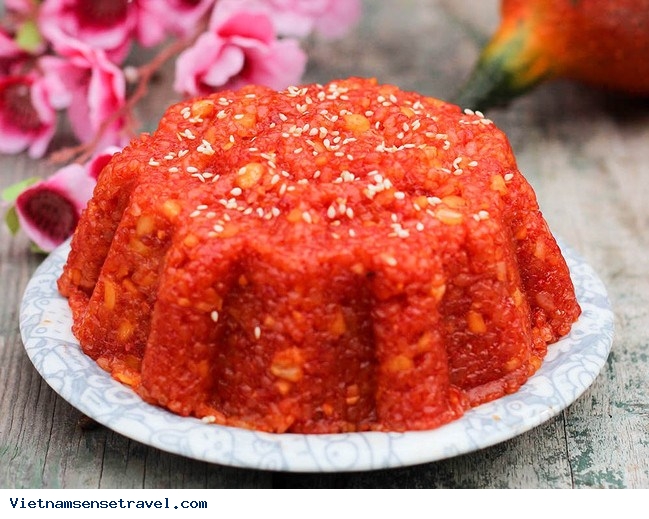
Soak glutinous rice in water overnight. Drain. Cut open the momordica (qua gac). Remove flesh and large black/red seeds. Mix this with a small cup of rice alcohol. Mix rice with salt and qua gac mixture.
Steam in a rice steamer. During steaming, add some chicken fat and stir through. When steamed, add a little sugar and stir through with chopsticks. Mound onto a plate and decorate with the black seeds from the fruit.
Che kho (Soft green bean cake)
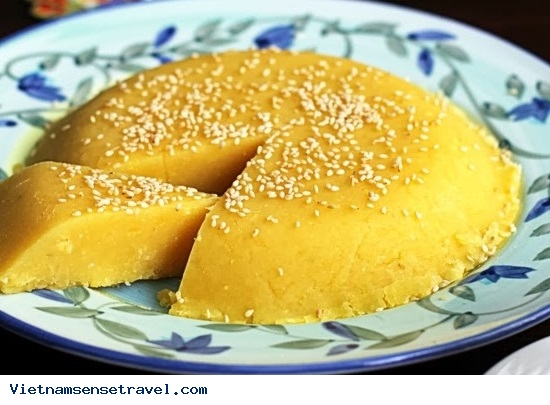
Soak green beans in water overnight to soften. Rub and remove skin. Drain. Cook in boiling water until soft. Drain and grind into a wet powder. Mix with sugar in a pan over a medium heat. Keep stirring until a little drier and smoother. Place in a mound and invert onto a plate. Sprinkle with sesame seeds. To serve, cut into slices like a cake.
Mut (Preserved fruit)
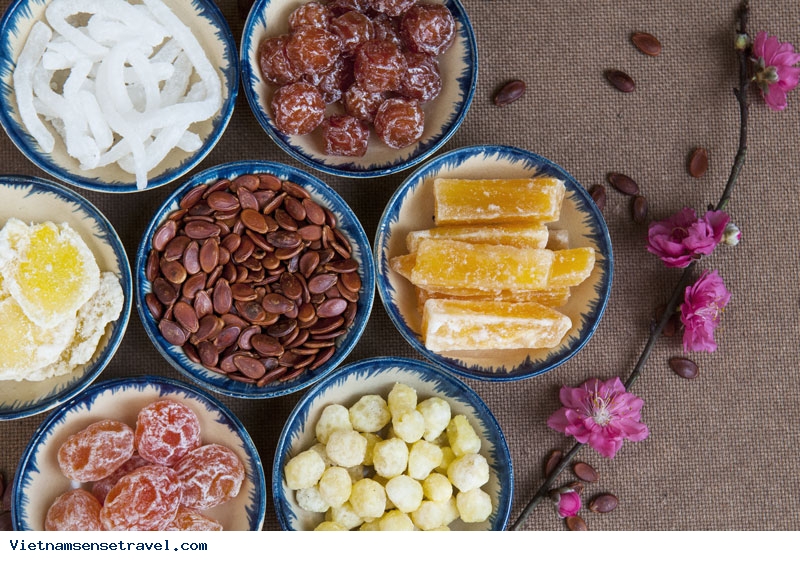
Prepare a week before Tet. The most important thing is to maintain the shape of the fruit. Use apple, potato, tomato, plum, ginger, mandarin, or gourd.
Apple: Pierce skin lengthwise, but don’t cut too deep. Place in a bowl of cold water and lime. Soak overnight. Wash carefully and dry. Cover in red sugar. Stir very carefully in a dry pan over low heat until sugar melts and solidifies. Take off heat. Press down carefully on top of apple to make into shape evocative of a seashell.
If using a kumquat, a traditional Tet fruit, use white sugar to keep the natural orange colour of the fruit. You must also keep the stalk in to keep the shape. You must also carefully press juice out after piercing skin.
Last, but not least
After indulging in all the above, remember that you cannot throw out any leftovers until the fourth day of Tet. It would also be highly inauspicious to sweep the rubbish from the house as all the good luck you have been working hard at will disappear with it.
-
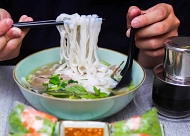 3 Noodle Dishes Made From Rice That Be Famous In Vietnam
3 Noodle Dishes Made From Rice That Be Famous In VietnamRice noodles are not only associated with the daily meals of Vietnamese people, but also become a feature of Vietnamese cuisine....
Our Travel consultants
-
![Ms. Thư - Sales Executive]() Ms. Thư - Sales Executiveinfo@vietsensetravel.com+84 976 489 888
Ms. Thư - Sales Executiveinfo@vietsensetravel.com+84 976 489 888
Testimonials
-
Show moreMai Chau - Pu LuongThuy Pham was very knowledge about the tour and super organized to ensure that I have the best experience from the tour. Mai Chau - Pu Luong was amazing with all the nature scenes and the friendly Thai minority in the village. I got to learn a lot of cultures in the area and how they are similar and different from the rest of other Vietnamese in the country...Mr. Tai Trinh - USAReview submitted on Jun 2022
-
Show moreEinfach KlasseIch bin selbe Vietnamesen, und auch sehr oft nach Vietnam reisen. Aber erstes Mal ein Tour von Reisefirma buchen. Erstaunlich, es war viel besser als erwartet. Zuerst, wir können richtig gut essen, zweite, wir bleiben immer fit mit sehr gute Zeitplannung. Ich muss noch mal Danke sagen und bis bald Vietsensetravel.Herzlichen GrüsseAntrus Duong - Germany
-
Show moreExcellent organizationWe made trip for 25pax with VietSense Travel. From the first email we understood that it is our company, our friends and our Vietnamese guides to history, sense and soul of this country.We traveled for 8 days from North to South trough the country, made best points of view with great gastronomic accents and nice hotels. The program was made for us individually according to our wishes and budget.VietSence Travel is the team of professionals - reliable, friendly and always ready to help in any issue. Surely recommend if you want to get great travel experience in Vietnam!Anastasiya Popovich - Ukraine
-
Show moreTrip in VietnamWow. A trip of a lifetime, we closed the trip six months before they took care of all the details even the smallest, their drivers are careful, the excellent guides explained everything to us with a smile and patience. We were taken to clean restaurants. Thank you so much from Israel.Sheli Golan - Israel
-
Show moreMy visit was from 6/1/2019 to 6/6/2019...My family of three really liked the tours Halong & Ninh Bình 2019 from Vietsense Travel. Travel consultant Thuy Pham, tour guides Viet & Dung gave us great experiences from these tours. The sight seeing were beautiful and amazing. We loved the foods, places that we had seen. They treated us so nice. Also, the drivers, boat guides were great. We will recommend these tours from Vietsense Travel. If we ever come back to Hanoi, we definitely will book tours from Vietsense Travel again...Chinh Vo - United States
-
Show moreFive Star Tour Agency with Excellent Service from Ms.Thuy Pham, Travel Advisor...Words simply cannot express the awesome job Ms.Thuy Pham did in planning every detail personally. She gave us more than 100% of her attention before the trip and during our time. We shared almost a personal relationship during the process that we even met for lunch in Hanoi! Thuy took the time to share our travel experiences mid-way through the trip. That gave us a true feeling of “Vietnam Hospitality”...Gloriacappo - North Chicago, Illinois








Vietsense Travel's Team
The VietSense Travel team consists of experienced tour specialists who have deep knowledge of Vietnam, Cambodia and Laos. We can assist with all your tour-related questions...
Contact Us














